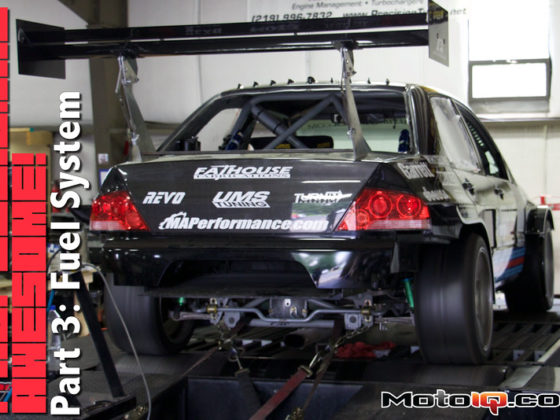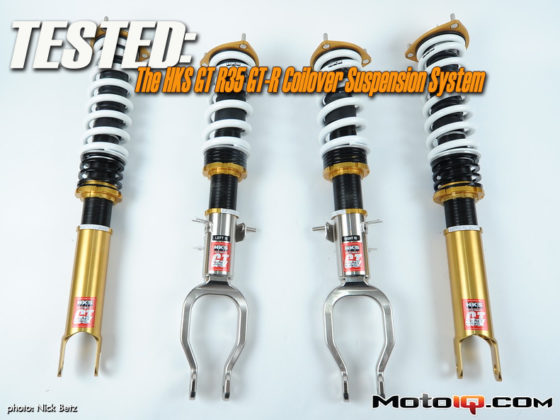
Lessons in Turbo Technology with Garrett – Burst Containment
What is burst containment for a turbocharger, and why is it important? A turbocharger is a system that has a lot of potential to cause a lot of bad stuff to happen to drivers, spectators, and surrounding equipment. Why, might you ask? Well, a typical turbocharger can spin at up to an unfathomable 200,000 rpm for a small frame turbo and a still amazing 90,000 rpm for a large frame turbo! That is a ton of potentially ass-kicking force. We will show you how much later, and it’s enough to make you cringe.
The turbine wheels are spinning at this amazing speed in a hot corrosive environment that approaches temperatures upwards of 1,950 degrees Fahrenheit or close to the melting point of steel. The compressor can operate at temperatures approaching 400 degrees Fahrenheit or what you might see in the broiler section of your oven. All this is going on while the system can be harnessing over a hundred horsepower of energy, converting exhaust heat and pressure into power increasing boost pressure.
This is all fine and dandy until something goes wrong. If issues cause a turbo’s compressor or exhaust wheels to burst, let’s roughly calculate the staggering amounts of energy that can be released. For a comparative analysis of the energy released by turbine wheel burst, consider the power of a high-powered rifle bullet being fired. Imagine a 250-grain bullet traveling at a velocity of 2,500 ft/s. This is a pretty powerful round, for instance- way more powerful than the 5.56 round fired from our military’s M4 carbine or an AR15, for instance.
Now consider a Garrett GT55R turbine wheel being spooled up past its safe speed limit. The tip speed of its Inconel turbine wheel just before its predicted burst speed is roughly equal to the muzzle velocity of our imaginary, high-powered rifle bullet. In other words, in both of these projectiles, the bullet and the tip of the GT55R turbine wheel pre-burst, are traveling at approximately 2,500 ft/s or 1,700 mph. This is given that the tip diameter of the GT55R turbine wheel is 111.5 mm (4.39 in) and its tip speed is 2,500 ft/s and the rotational speed of the wheel is 130,500 rpm. This is well into the turbo’s unsafe over-speed zone; in fact, it is 39,500 rpm past the wheel’s safe speed limit of 91,000 rpm.
By measuring the moment of inertia (I) of the GT55R turbine wheel and knowing the rotational speed (W), we can calculate that the kinetic energy stored by the wheel just before burst is around 60,000 lb-ft (by E sub k =1⁄ 2lw squared). Going back to our bullet’s ballistics, It’s mass at 250 grains is equal to 0.036 lbs. Therefore the kinetic energy stored by our 250-grain bullet leaving the barrel is 3,470 lb-ft (by E sub k=1 ⁄2 mv squared ).
Comparing the two ballistic projectiles, we can liken the GT55R turbine wheel’s pre-burst energy to the equivalent of firing 17 (by (60,000) / (3,470) = 17.3) of our proposed bullets simultaneously. The actual energy that the turbine housing will absorb will be less, however, because turbine wheels will usually break into three large pieces when the hub bursts. Each of these pieces will travel at about 1/2 of the tip speed of the pre-burst wheel tip speed, and has about 1/3 of the mass of the entire wheel. Therefore the kinetic energy of each piece is about 22% of the total pre-burst wheel energy. Now consider these three pieces flying towards the turbine housing: (22% of pre-burst energy) x (3 pieces) = 66% of the pre-burst energy must be absorbed by the housing in total, which is (60,662 lb-ft) x (0.66) = 40,037 lb-ft of energy. That is still nasty or about the same energy of 11 of our high powered rifle bullets being fired at once at point blank range.
Getting hit by one of those unconstrained pieces would be about the equivalent of being shot about 4 times with our proposed bullet- that would hurt! The cold hard math shows the importance of having your turbo’s housings being designed to contain the parts within itself just in case something goes wrong!
When choosing a turbocharger, you might want to consider if it’s housings can stop the equivalent of being hit simultaneously by eleven high powered rifle rounds at point blank range. If it’s a true Garrett turbine housing, then it was intentionally designed and qualified to contain the wheel. Therefore, you can bet the answer is “yes.”
Select concepts in this article as referenced from the Garrett white paper are used with permission of Honeywell, Inc.

What exactly is Turbo burst?
Burst is basically when the spinning wheels inside the turbo blow up. There are two major types of wheel burst: blade and hub. A blade burst occurs when the centrifugal forces at speed acting to pull the blades off of the central hub overcomes the mechanical strength of the blades root section connecting the blades to the hub. Under these conditions, if a blade root is too weak it can be torn from the hub as easily as a petal is ripped from a flower.
Hub burst, on the other hand, is an extreme burst wherein the main hub that the blades are attached to reaches its ultimate strength limit and breaks into two, three or more large pieces through the centerline of the wheel. The hub is more compact than the blades and is a continuous mass, which therefore means it is stronger than the root of each thin blade. However, the hub centerline is at the rotational centerline of the wheel, meaning that the internal stresses are at their maximum at the hub’s core.
The hub can burst at extreme speeds and temperatures. In some cases, it may burst after the blades have already burst and been ejected. During a Garrett® burst containment housing qualification test, the hub is intentionally weakened to cause a worst case scenario burst. Whatever the reason for hub burst, though, it has the highest potential for damaging the housing and its surroundings because it is the heaviest single portion of the wheel and releases the largest amount of energy. In the case of a turbine wheel hub burst, the heaviest spinning portion of the entire turbocharger comes apart with explosive force.
Even though a hub burst is, fortunately, a rare occurrence in practice, Garrett qualifies its aftermarket and OE production turbochargers for containment of a worst-case-scenario wheel burst.
 Every Garrett turbo must pass burst testing as part of its normal validation for production approval. Here, a GT5533R is made ready for its test.
Every Garrett turbo must pass burst testing as part of its normal validation for production approval. Here, a GT5533R is made ready for its test.


